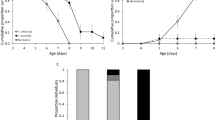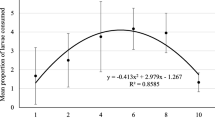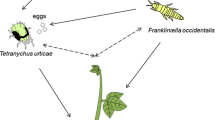Abstract
Optimal foraging theory predicts that predators prefer those prey species that are most rewarding in terms of reproductive success, which is dependent on prey quality and prey availability. To investigate which selection pressures may have moulded prey preference in an acarine system consisting of two prey species and three predator species, we tested whether prey preference of the predators is matched by the associated reproductive success.
The predators involved areAmblyseius finlandicus (Oudemans),Am. potentillae (Garman) andTyphlodromus pyri Scheuten. The prey species are the apple rust mite (Aculus schlechtendali (Nalepa)) and the fruit-tree red spider mite (Panonychus ulmi (Koch)).
Reproductive success was assessed in terms of intrinsic rate of increase and for one predator also in terms of diapause induction. All three predator species reached highest reproductive success on the same prey species: apple rust mite. This was most pronounced for the predatorAm. finlandicus, because its larval stage suffered severe mortality when feeding onP. ulmi.
An independent study on prey preference of the three predator species (Dicke et al., 1988) revealed thatAm. finlandicus prefersAc. schlechtendali toP. ulmi, whereas the other two predator species have the reverse preference.
Thus, on the basis of current data, prey preference ofAm. finlandicus can be understood in terms of reproductive success. However, this is not so for prey preference ofT. pyri andAm. potentillae. Investigations needed for a better understanding of prey preference of the last-named two predator species are discussed.
Similar content being viewed by others
References
Amano, H. and Chant, D.A., 1977. Life history and reproduction of two species of predacious mites,Phytoseiulus persimilis Athias-Henriot andAmblyseius andersoni (Chant) (Acarina: Phytoseiidae). Can. Zool., 55: 1978–1983.
Amano, H. and Chant, D.A., 1986. Laboratory studies on the feeding habits, reproduction and development of three phytoseiid species,Typhlodromus pomi, Phytoseius macropilis andAmblyseius finlandicus (Acari: Phytoseiidae), occurring on abandoned apple trees in Ontario, Canada. Exp. Appl. Acarol., 2: 299–313.
Chant, D.A., 1959. Phytoseiid mites (Acari: Phytoseiidae). Part. I. Bionomics of seven species in southeastern England. Can. Entomol., 91, Suppl. 12: 5–44.
Dicke, M., 1988. Prey preference of the phytoseiid miteTyphlodromus pyri: 1. Response to volatile kairomones. Exp. Appl. Acarol., 4: 1–13.
Dicke, M. and de Jong, M., 1988. Prey preference of the phytoseiid miteTyphlodromus pyri: 2. Electrophoretic diet analysis. Exp. Appl. Acarol., 4: 15–25.
Dicke, M., Sabelis, M.W. and de Jong, M., 1988. Analysis of prey preference in phytoseiid mites by using an olfactometer, predation models and electrophoresis. Exp. Appl. Acarol., 5: 225–241.
Easterbrook, M.A., 1979. The life-history of the eriophyid miteAculus schlechtendali on apple in south-east England. Ann. Appl. Biol., 91: 287–296.
Gruys, P., 1982. Hist and misses. The ecological approach to pest control in orchards. Entomol. Exp. Appl., 31: 70–87.
Hayes, A.J. and McArdle, B.M., 1987. A laboratory study on the predatory miteTyphlodromus pyri (Acarina: Phytoseiidae): I. The effect of temperature and food consumption on the rate of development of the eggs and immediate stages. Res. Pop. Ecol., 29: 73–88.
Herbert, H.J., 1961. Influence of various numbers of prey on the rate of development, oviposition, and longevity ofTyphlodromus pyri Scheuten (Acarina: Phytoseiidae) in the laboratory. Can. Entomol., 93: 380–384.
Jeppson, L.R., Keifer, H.H. and Baker, E.W., 1975. Mites Injurious to Economic Plants. University of California Press, Berkeley, 614 pp.
Kropczynska, D., 1970. Biology and ecology of the predatory miteTyphlodromus finlandicus (Oud.) (Acarina: Phytoseiidae). Zesz. Probl. Post. Nauk. Roln. 109: 11–42. (in Polish).
Kropczynska-Linkiewicz, D., 1971. Studies on the feeding of four species of phytoseiid mites (Acarina: Phytoseiidae). In: Proc. 3rd International Congress of Acarology, Prague, 1971, pp. 225–227.
Lotka, A.J., 1925. Elements of Physical Biology. Williams & Wilkins, Baltimore, 460 pp.
McMurtry, J.A., 1977. Some predaceous mites (Phytoseiidae) on citrus in the Mediterranean region. Entomophaga, 22: 19–30.
McMurtry, J.A. and van de Vrie, M., 1973. Predation byAmblyseius potentillae (Garman) onPanonychus ulmi (Koch) in simple ecosystems (Acarina: Phytoseiidae, Tetranychidae). Hilgardia, 42: 17–33.
Overmeer, W.P.J., 1981. Notes on breeding phytoseiid mites from orchards (Acarina: Phytoseiidae) in the laboratory. Meded. Fac. Landbouwwet. Rijksuniv., Gent, 46: 503–509.
Overmeer, W.P.J., 1985a. Diapause. In: W. Helle and M.W. Sabelis (Editors), Spider Mites, Their Biology, Natural Enemies and Control, Vol. B. Elsevier, Amsterdam, pp. 95–102.
Overmeer, W.J.P., 1985b. Rearing and handling. In: W. Helle and M.W. Sabelis (Editors), Spider Mites, Their Biology, Natural Enemies and Control, Vol. B. Elsevier, Amsterdam, pp. 161–170.
Overmeer, W.P.J. and van Zon, A.Q., 1983a. The effect of different kinds of food on the induction of diapause in the predacious miteAmblyseius potentillae. Entomol. Exp. Appl. 33: 27–30.
Overmeer, W.P.J., and van Zon, A.Q., 1983b Resistance to parathion in the predacious miteTyphlodromus pyri Scheuten (Acarina: Phytoseiidae). Meded. Fac. Landbouwwet. Rijksuniv. Gent, 48: 247–251.
Rabbinge, R., 1976. Biological control of the fruit tree red spider mite. Pudoc, Wageningen, 228 pp.
Sabelis, M.W., 1981. Biological control of two-spotted spider mites using phytoseiid predators. Part I: Modelling the predator-prey interaction at the individual level. Pudoc, Wageningen, Agric. Res. Rep. 910, 242 pp.
Sabelis, M.W., 1985a. Capacity for population increase. In: W. Helle and M.W. Sabelis (Editors), Spider Mites, Their Biology, Natural Enemies and Control, Vol. B. Elsevier, Amsterdam, pp. 35–42.
Sabelis, M.W., 1985b. Sex allocation. In: W. Helle and M.W. Sabelis (Editors), Spider Mites, Their Biology, Natural Enemies and Control, Vol. B. Elsevier, Amsterdam, pp. 83–194.
Sabelis, M.W., 1985c. Reproduction. In: W. Helle and M.W. Sabelis (Editors), Spider Mites, Their Biology, Natural Enemies and Control, Vol. B. Elsevier, Amsterdam, pp. 83–94.
Sabelis, M.W. and van de Baan, H.E., 1983. Location of distant spider mite colonies by phytoseiid predators: demonstration of specific kairomones emitted byTetranychus urticae andPanonychus ulmi. Entomol. Exp. Appl., 33: 303–314.
Schliesske, J., 1977. Untersuchungen zur Morphologie, Biologie und Verbreitung vonAculus fockeui (Nal. et Trt.) (Acari: Eriophyidae) in Niedersachsen. Ph.D. Thesis, Technical University of Hannover, F.R.G.
Sokal, R.R. and Rohlf, F.J., 1981. Biometry (2nd edition) Freeman, San Francisco, 859 pp.
Van de Vrie, M., 1973. Studies on prey-predator interactions betweenPanonychus ulmi andTyphlodromus potentillae (Acarina: Tetranychidae, Phytoseiidae) on apple in the Netherlands. In: Proc. FAO Conference of Ecology in Relation to Plant Pest Control. FAO, Rome, pp. 145–160.
Van Epenhuijsen, C.W., 1981. Vruchtboomgalmijt (Aculus schlechtendali Nal.) een niet te onderschatten plaag in de appelboom. Fruitteelt, 71 (8): 239–241 (in Dutch).
Van Houten, Y.M., Overmeer, W.P.J. and Veerman A., 1987. Thermoperiodically induced diapause in a mite in constant darkness is vitamin A dependent. Experientia, 43: 933–935.
Van Zon, A.Q., Overmeer, W.P.J. and Veerman, A., 1981. Carotenoids function in photoperiodic induction of diapause in a predacious mite. Science, 213: 1131–1133.
Veerman, A., Overmeer, W.P.J., van Zon, A.Q., de Boer, J.M., de Waard, E.R. and Huisman, H.O., 1983. Vitamin A is essential for photoperiodic induction of diapause in an eyeless mite. Nature, 302: 248–249.
Zaher, M.A. and Shehata, K.K., 1971. Biological studies on the predator miteTyphlodromus pyri Sch. (Acarina: Phytoseiidae) with the effect of prey and non-prey substances. Z. Angew. Entomol., 67: 389–394.
Author information
Authors and Affiliations
Rights and permissions
About this article
Cite this article
Dicke, M., Sabelis, M.W., De Jong, M. et al. Do phytoseiid mites select the best prey species in terms of reproductive success?. Exp Appl Acarol 8, 161–173 (1990). https://doi.org/10.1007/BF01194177
Accepted:
Issue Date:
DOI: https://doi.org/10.1007/BF01194177




